OO ROO, ULURU
The Australian saying "see ya later" is often "Oo Roo."
I left in -2°Canberra in darkness, for the 6:10 AM flight to Alice Springs, via Melbourne. Packed planes for both legs (literally and figuratively) in a Boeing 737. From my centre seat, saw little of the countryside, other than the brown land, the mouldy, straw-yellow sparse ground-covering, on approaching Alice Springs. Clear azure skies. Stairs wheeled to both ends of the aircraft, to disgorge its entrails into a fairly modern small terminal. Then the bus to my hotel, the Doubletree by Hilton, for my last night of luxury.
Australia is, beyond the cities, first "the bush," then beyond the bush, there are the plains, and beyond the plains, there is the "outback." A place, where men are strong, hardy and rugged, and the women so, too. Tyrannised by remoteness, isolation, sparse communication, distance education, once by pedal radio, now by by the wonders of satellite Skype. And of course, medical care, often from distant locations, by the Royal Flying Doctor Service based in the heart of the Red Heart, Alice Springs .
I walked in to Alice Springs passing through the bed of the Todd River, which is simply just a snaking, sand bottom, although each year, Alice stages the "Henley on Todd" regatta, using colourful Dragon boat type vessels, with the bottoms cut out, and a whole lot legs propelling the competing craft along the river floor, looking to all like boats, with not a skerrick of water in sight! Nearby, there are some attractive Colonial era buildings, and of course, there is the site of the now fully restored, 19th century Telegraph station, which, via Morse code, connected other parts Australia with the outside world.
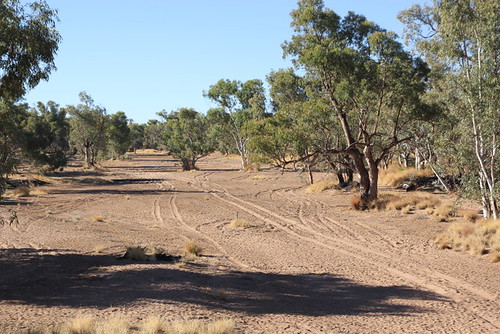
Todd River
Alice struck me as a large country town, reached via a cleft in the McDonnell Ranges. Lots of indigenous Australians, lolling about in a park, some of them wearing jumpers and hoods, while the temperature was in the high 20s. It was incongruous therefore to hear that unemployment among aboriginals was high, therefore surprisingly to see that most of the staff in the hotels and shops were Asians. In my view, the jobs could better have been awarded to aboriginals. Shopkeepers I spoke to said that while they dearly wanted to employ aboriginals, while initially willing workers, all too often, found them unreliable, which left the business in the lurch while they went off to do deal with tribal matters. Many aboriginals have become doctors, lawyers, and other professionals. But a lot of work has to be done by other Australians, in conjunction with the aboriginals themselves, to have more aboriginal participation the wider community and raise living standards, more focussed education, health, welfare services, and work opportunities commensurate with lifestyles enjoyed by much in the rest of Australia.
For me, time had really stood still. My Swiss watch was no longer working. Only in Alice was there a watchmaker who could make the repairs, otherwise it would have been sent to Adelaide, Sydney, or Melbourne! Hours away, flying. Not a timepiece in the timeless land - too much to bear. So much of my trip ran to a very tight schedule with early morning starts every day. For we older fellas, a watch is essential kit.
I had joined a tour group to go and lie around a campfire, a swag, a thin "Rubber mattress," in a sleeping bag, that inside a "coffin bag," to ward off the -2°cold. It was the first time I had been camping in well over 50 years!
The next morning at 05:30, the Lost in Australia Tour group came calling in a 20 seater minibus, towing a little trailer which I assumed was for luggage. Instead we had to store our bags in the van, for the little trailer was saved for the "on board kitchen" and carried our campfire firewood, for which we were expected to forage, in the sparse, spindly brush. Just with our labour, not a chainsaw in sight. Big stumps to burn longer...
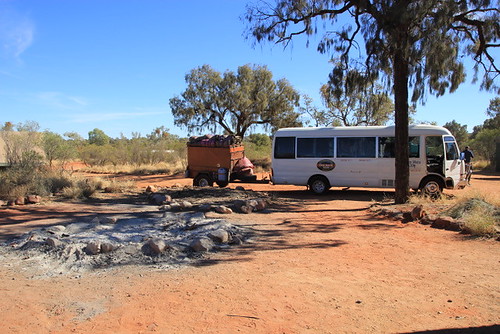
Our mini-bus, with swags on the trailer and the campfire remnants
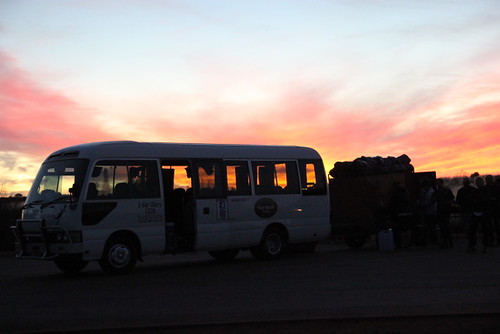
Our mini-bus with its trailer topped with swags

The back of the Truck cuisine
In the darkness, we set off for Uluru, 460 kms away. A mottled crew including the German driver and two of his countrymen, a Frenchman, a Chinese, a Kiwi, two Americans, one a lovely lady from Mississippi with a southern drawl which I could have a listen to for ages, and assorted Australians. Our driver, Patrick, drove with great speed and skill, and from my chair I recalled that in parts of the Northern Territory, because of the long and straight stretches of road, there was no speed limit. I mollified my anxiety that Patrick was from the country of Michael Schumacher, Sebastian Vettel, and the current world champion Nico Rosberg. Good parentage and pedigree, but ... I consoled myself that Schumacher's accident came while skiing!
When the sun threw off the blanket of darkness, the land starkly materialised, trees spindly and thin, rocky knobs, the bushes that I had seen in the darkness were sheep and, further on, cattle. The land dry "green" virtually absent, except on distant property where a grazier had access to an artesian bore. The leaves of the gum trees were an olive-greyish colour, hardened by nature, which here was a ferocious foe.
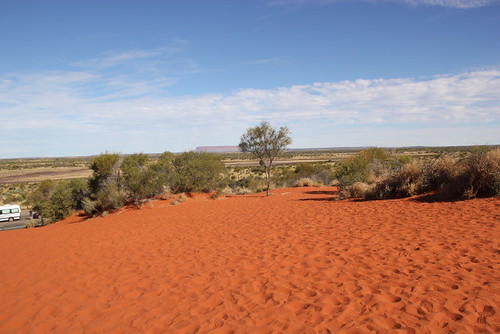
The red earth looking towards Mt Townsend
Aboriginals had walked these parts for centuries, and explorers of the outback soon discovered that the sturdy camel was the real ship of the desert. I am sure the same stares, wonder, and fear, as when Pesaro confronted the Incas on horseback. Earlier British-led explorations were done largely on horseback, which simply died in the harsh outback conditions. The introduction of camels came in the 1850s, when prospectors searched for the glint of gold in the rugged Australian bush and later on the fringes of the outback. When the gold ran out, the camels (not their Afghan riders!) were invariably turned loose. (As an aside, the camels went forth and multiplied, grew stronger, more resilient, and now, are much sought in the Middle East for their resilience and hardiness as racing camels and breeding stock!)
After nearly 3 hours in our minivan, we stopped at a Roadhouse for relief, and a coffee! Then it was on to firewood gathering, and finally, as the Rock loomed into sight, we went to the Uluru (formerly Ayres Rock) Kata Tjuta (formerly the Olgas) National Park. Welcome to Aboriginal Land.
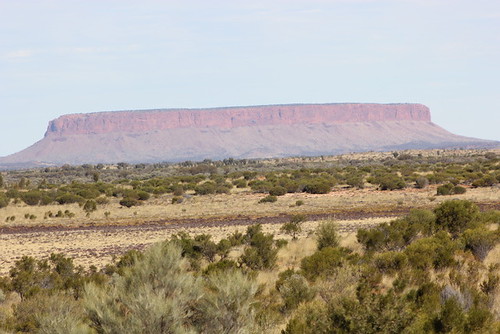
Mt Townsend on the way to Uluru
There, we went to a wonderful aboriginal exhibition which introduced us to the Aboriginal world with its spiritual and folkloric stories of attachment to the land in this part of Australia. There was also a film showing of the maltreatment of Aboriginals, who were not included in the Australian Constitution, nor even Australian censuses, till 1967.
For a long time, Aboriginals were not recognised as the land owners of what became the Uluru and other parts of Australia, until in 1992, the Australian High Court gave the "Mabo" (the name of the law-challenging individual) judgement that Australia was not "terra nullius" (Nobody's Land) when, in 1788, it was claimed by Britain. The Mabo judgement agreed that Aboriginals had prior title, and therefore rights to parts of the land.
The Aboriginal Centre had a wonderful vista of the Rock, but in deference to aboriginal custom, we were asked not to photograph the Rock from the Centre. There would be other places where this could be done, including from the base of the Rock. Aboriginals also asked people not to climb the Rock, for not only have some left mess on top, there are no toilet facilities, and 35 people, to date, have fallen to their deaths. Such deaths affect the spiritual world, so important to aboriginals. I dutifully signed the petition urging people not to walk on the Rock.
My colleagues chose to make the walk around the base, but much of it was on stony pathways and I deferred to just seeing their photographs. Months earlier, I had sought to visit Uluru, but while out walking, fell and was hospitalised for weeks, so I am very wary of rocky trails.
There is certainly spirituality and a sense of awe, when hundreds of tourists gathered at a vantage point to watch the way the sunset spectacularly changes the colour of Uluru. How it goes from grey edifice to warmer colours, to desert red, to rich purple, and ultimately, blackness. Tour operators assemble tables and open bottles of champagne and wine while watching the spectacle unfold. Even our more modest tour company served up a very tasty meal from the "kitchen," which materialised from the back of the trailer. Our touring "crew" helped with set up, and afterwards washing up, a habit which was our daily routine.

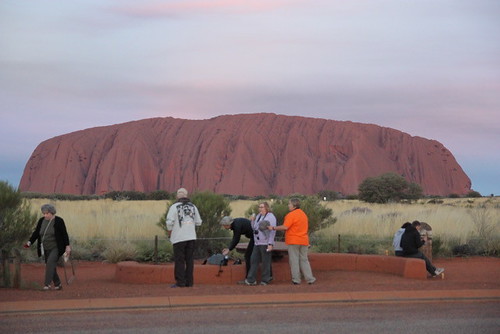

Uluru changing colour at dusk
Afterward, in the soft darkness, we drove to our campsite, rolled out our swags, and like spokes on a wheel, placed them around the campfire site. Patrick soon had a roaring fire going.
Then a few of us walked to a place where we stopped to look up at the stars like I had never really seen them before. They looked so close and clear that it was simply breathtaking, and not just because it was -2°. I had never seen the Milky Way so clear, like a spread of whitish celestial spray, flecked in little white pepper balls, all a twinkle. For centuries, the mariners guided via the Southern Cross, making sure that no one was travelling in the wrong direction this night. There was a sliver of moon, lighting up the landscape almost like daylight. The air was so clear.
Later, by the campfire, the superlatives flowed like the flames and everyone agreed - it was simply stupendous. We all gave a little personal "pen picture" while toasting marshmallows. And so to our earthly bed, a very thin rubber mattress, then zipping into sleeping bags, which then we zipped into a heavy canvas/rubber "coffin bag" to tackle the cold, with just the crackle of the fire as our nighttime music. It took a while to get to sleep, as much due to the celestial majesty as the biting cold. Time to contemplate and think philosophical thoughts, like, what is a 71 year old man doing, camping like this! Most just stayed in heavy tracksuits and beanies, a shower tomorrow!
The next morning it was up before the dawn, roll up and stow the swag, to drive to a sunrise over the Kata Tjuta rocks, another spectacle with the Sun's brush, colouring they rock surface as would be taking place at nearby Uluru. Another back of the trailer breakfast, and on to the nearness of Kata Juta herself. More walking, again a rocky trail. I picked my way between the rocks, exercising great care while the rest went on a longer walk. Busloads of tourists making the walks, even the short one that I did, again wonderful views of "nature's marbles," scattered so loosely on the desert floor. The pedants among you will say the whole region was part of a massive volcanic upheaval, millions of years ago, Uluru and Kata Tjuta among them! More romantic to see them as the work of the spirit gods.
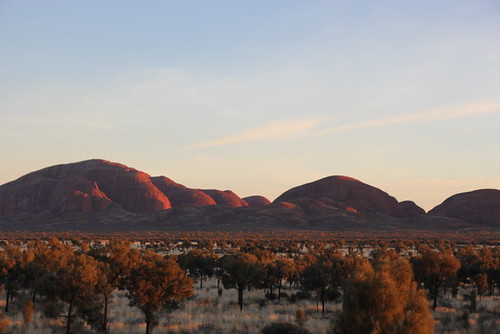
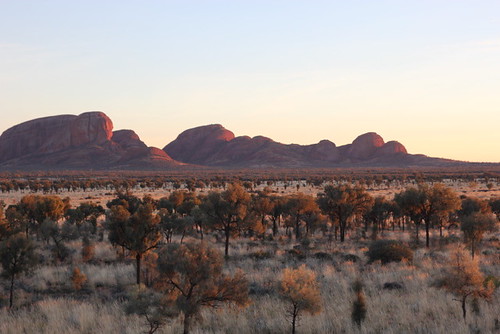
Kata Tjuta at first light
Another two hours driving, log gathering again, of course, and we were at our next campsite near Kings Canyon. A simply brilliant coming of the night scene, a sky as reddish as the land. Below the fading sun, a great salt lake, which went for miles, gave its warming reflection. When I asked locals what was the name of the lake, they simply said, what lake?
Another campfire and a night under the stars, somehow not as cold as last night, or maybe my body had just given up on my foolishness! Maybe it was the hot shower I'd insisted on taking...?
Next day, after our morning chores, we set off for Kings Canyon, an hour away. Again, I took the lower Canyon walk, picking my way very carefully over the many small, boulder strewn rocks. There is nothing like fearing another fall, which is rather intimidatory! The walk ended after a kilometre, where a boulder, the size of two double-decker buses joined at the hip, had fallen across the track, and tourists were advised not to proceed further. I heeded the advice and came back, taking some good photos, only to discover that a helicopter service offered visitors a 20 minute aerial reconnaissance for $55 per seat. Cheap indeed, but I discovered this too late to partake.
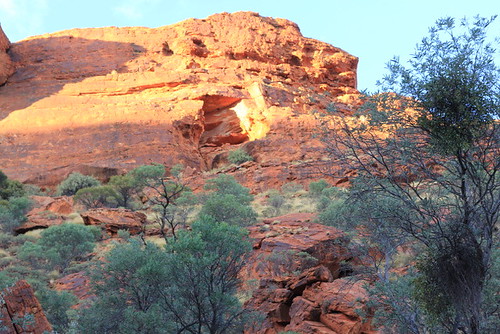
Rock fall at Kings Canyon
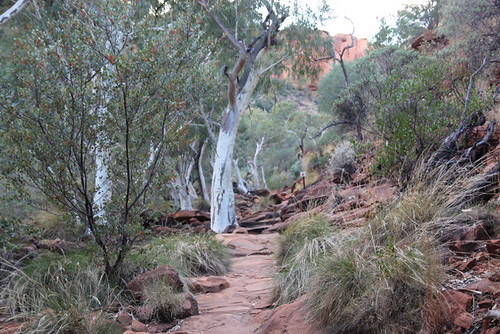
The pathway up the King’s Canyon amid the White Gum trees
The group took the clifftop walk. Here last year, an enthusiastic lady had gone beyond the safety barrier to the cliff edge to snap an "unforgettable photo" into the canyon. It was the last photo she ever took, as the overhang simply crumbled and she had a life-ending, 200 feet fall to the canyon floor. Our intrepid group heeded the advice, stayed back, got some good shots.
Home-time, and a six hour trip back to Alice Springs, quite enjoyable as the countryside, earlier dark 2 days ago, looked interesting, with lots of rocky tors and distant cattle stations - one the same size as Belgium. The lunch stop was at another grubby Roadhouse and I wondered what foreign tourists would have thought of the facilities. A "cattle train" with three wagons stood at the roadside. I imagined a blue singleted truckie was inside getting a burger!
Our last stop, a dozen kilometres from Alice Springs, was at a camel farm, and Patrick asked if anyone wanted to ride a camel. While living in Bahrain, there was a nearby camel farm and riding one was the last thing I wanted to do. The ones that I had seen were nasty, cantankerous, spitting, biting beasts. No thank you very much!
Half an hour later, I returned to the Hilton. Nirvana: a shower, crisp sheets a comfortable King-size bed, lie back and luxuriate, rich indelible memories of wonderful scenery and an unforgettable night under the stars. The hard earth floor, the -2° overnight temperature, and the arduous gathering of firewood were soon forgotten in the recall of the roaring camp-fire and the camaraderie of my "new friends."
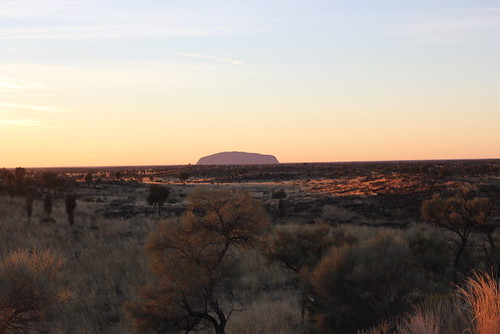
Uluru the next morning from Kata Tjuta
Winfred Peppinck is the Tales of the Traveling Editor for Wandering Educators
All photos courtesy and copyright Winfred Peppinck
